User:Wolverine XI/sandbox3
| Felidae[2] | |
|---|---|
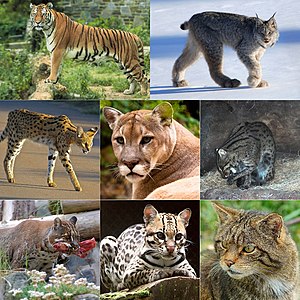 | |
| Scientific classification | |
| Domain: | Eukaryota |
| Kingdom: | Animalia |
| Phylum: | Chordata |
| Class: | Mammalia |
| Order: | Carnivora |
| Suborder: | Feliformia |
| Superfamily: | Feloidea |
| Family: | Felidae Fischer von Waldheim, 1817 |
| Type genus | |
| Felis | |
| Genera and Subfamilies | |
| |

| |
| Distribution of Felinae (blue) and Pantherinae (green) | |
Felidae is a family of mammals which comprises all species of cats. There are currently 41 extant species of Felidae, this includes both domestic cats and wild cats like lions, tigers, leopards, cheetahs, and many others. Felidae is the most diverse family of carnivorous mammals and is characterized by their retractable claws, sharp teeth, keen senses, and agile bodies. The family Felidae is believed to have originated around 25 million years ago in Asia. Over time, felids have evolved to occupy various habitats across the world. They can be found in different environments, such as forests, grasslands, deserts, and even high-altitude regions like the Himalayas. The diversity of habitats has led to the development of remarkable adaptations in each species.
One of the most distinguishing features of felids is their keen eyesight. They have excellent night vision due to a reflective layer behind their retinas called the tapetum lucidum, which enhances their visual perception in low light conditions. Felids also possess excellent hearing, an acute sense of smell, and highly sensitive whiskers that aid in their hunting abilities. Felids have adapted to become highly efficient predators. They are carnivorous animals, meaning they primarily feed on meat. Their teeth are designed for gripping, tearing, and slicing flesh, while their retractable claws allow them to capture their prey with precision. Felids also have muscular bodies and powerful hind limbs, which enable them to stalk, pounce, and chase their prey effectively.
The social behavior of felids varies greatly between species. Some felids, like lions, are social animals that live in prides or groups. They exhibit complex social structures and engage in cooperative hunting. On the other hand, most felids are solitary animals. They prefer to live and hunt alone, marking their territories to warn other individuals to stay away. Felids reproduce through sexual reproduction. Most species have a polygamous mating system, where dominant males establish territories and mate with multiple females. Female felids give birth to litters of one to six cubs, depending on the species. The cubs are born blind and helpless, and the mother provides them with milk until they are old enough to start consuming solid food. Humans have a long and complex relationship with felids. Domestic cats, which are members of the felid family, have been domesticated and kept as companions for thousands of years. They are one of the most popular pets worldwide and are adored for their playful nature and independent personalities. On the other hand, interactions between humans and large wild felids can sometimes be dangerous, leading to conflicts and occasional attacks.
Many felid species are facing significant threats in the wild. Habitat loss, poaching, and illegal wildlife trade pose significant risks to their populations. Several felid species are listed as endangered or critically endangered by the International Union for Conservation of Nature (IUCN). Conservation efforts are crucial to protect and preserve these magnificent creatures and their habitats.
Etymology[change | change source]
The Latin word "felis" can be traced back to the Proto-Indo-European root word "*peli-" meaning "gray."[3] From this root, the word underwent various modifications in different languages. In ancient Greek, it evolved into "aílx," meaning "lynx." The Romans then borrowed this Greek term and transformed it into "felis" to refer to the domestic cat.
The concept of Felidae extends beyond Latin and Greek etymology. It is interesting to note that the ancient Egyptians called cats "mau," which resembled the sound they made.[4] Greek philosopher Aristotle also used the term "ailouros" to describe domestic cats, which is a compound of "ai" meaning "earth" and "lōros" meaning "capturing."
Furthermore, the word "cat" itself has its own etymology. It is derived from the Old English word "catt," which can be traced back to the Late Latin word "cattus" or "catta."[5] These Latin words were most likely borrowed from an African language, possibly Nubian or Egyptian.[6] Interestingly, the word "cattus" was also used in medieval Latin to refer to a specific kind of hunting cat.
Taxonomy[change | change source]
Evolution[change | change source]
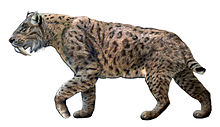

The family Felidae is part of the Feliformia, a suborder that diverged probably about 50.6 to 35 million years ago into several families.[7] The Felidae and the Asiatic linsangs are considered a sister group, which split about 35.2 to 31.9 million years ago.[8]
The earliest cats probably appeared about 35 to 28.5 million years ago. Proailurus is the oldest known cat that occurred after the Eocene–Oligocene extinction event about 33.9 million years ago; fossil remains were excavated in France and Mongolia's Hsanda Gol Formation.[9] Fossil occurrences indicate that the Felidae arrived in North America around 18.5 million years ago. This is about 20 million years later than the Ursidae and the Nimravidae, and about 10 million years later than the Canidae.[10]
In the Early Miocene about 20 to 16.6 million years ago, Pseudaelurus lived in Africa. Its fossil jaws were also excavated in geological formations of Europe's Vallesian, Asia's Middle Miocene and North America's late Hemingfordian to late Barstovian epochs.[11]
In the Early or Middle Miocene, the sabre-toothed Machairodontinae evolved in Africa and migrated northwards in the Late Miocene.[12] With their large upper canines, they were adapted to prey on large-bodied megaherbivores.[13][14] Miomachairodus is the oldest known member of this subfamily. Metailurus lived in Africa and Eurasia about 8 to 6 million years ago. Several Paramachaerodus skeletons were found in Spain. Homotherium appeared in Africa, Eurasia and North America around 3.5 million years ago, and Megantereon about 3 million years ago. Smilodon lived in North and South America from about 2.5 million years ago. This subfamily became extinct in the Late Pleistocene.[12]
Results of mitochondrial analysis indicate that the living Felidae species descended from a common ancestor, which originated in Asia in the Late Miocene epoch. They migrated to Africa, Europe and the Americas in the course of at least 10 migration waves during the past ~11 million years. Low sea levels, interglacial and glacial periods facilitated these migrations.[15] Panthera blytheae is the oldest known pantherine cat dated to the late Messinian to early Zanclean ages about 5.95 to 4.1 million years ago. A fossil skull was excavated in 2010 in Zanda County on the Tibetan Plateau.[16] Panthera palaeosinensis from North China probably dates to the Late Miocene or Early Pliocene. The skull of the holotype is similar to that of a lion or leopard.[17] Panthera zdanskyi dates to the Gelasian about 2.55 to 2.16 million years ago. Several fossil skulls and jawbones were excavated in northwestern China.[18] Panthera gombaszoegensis is the earliest known pantherine cat that lived in Europe about 1.95 to 1.77 million years ago.[19]
Living felids fall into eight evolutionary lineages or species clades.[20][21] Genotyping of nuclear DNA of all 41 felid species revealed that hybridization between species occurred in the course of evolution within the majority of the eight lineages.[22]
Modelling of felid coat pattern transformations revealed that nearly all patterns evolved from small spots.[23]
Classification[change | change source]
Traditionally, five subfamilies had been distinguished within the Felidae based on phenotypical features: the Pantherinae, the Felinae, the Acinonychinae,[24] and the extinct Machairodontinae and Proailurinae.[25] Acinonychinae used to only contain the genus Acinonyx but this genus is now within the Felinae subfamily.[26]
Phylogeny[change | change source]
The following cladogram based on Piras et al. (2013) depicts the phylogeny of basal living and extinct groups.[27]
| Felidae |
| |||||||||||||||||||||||||||||||||||||||||||||||||||||||||||||||||||||||||||||||||||||||
The phylogenetic relationships of living felids are shown in the following cladogram:[22]
| Felidae |
| ||||||||||||||||||||||||||||||||||||||||||||||||||||||||||||||||||||||||||||||||||||||||||||||||||||||||||||||||||||||||||||||||||||||||||||||||||||||||||||||||||||||||||||||||||||||||||||||||||||||||||||||||||||||||||||||||||||||||||||||||||||||
Physical characteristics[change | change source]
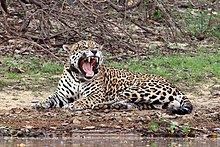
First and foremost, felids have a compact and muscular body structure. This allows them to be agile and quick, making them effective hunters.[28] Their bodies are well-adapted for stealthy movements and sudden bursts of speed.[29] The muscular structure also provides strength to capture and overpower their prey. Felids have a comparatively small and rounded head with a short muzzle.[30] Their skulls are specially designed to accommodate strong jaw muscles, which help in delivering powerful bites.[29] The shape of their heads and muzzles varies slightly among different species, but the general characteristic of a rounded head is common to all felids.[31]
Most felids have a set of retractable claws. These sharp and curved claws are vital for hunting and climbing.[32] While hunting, felids extend their claws to grasp prey, and when not in use, they retract them[33] and keep the sharp tips protected within a sheath of skin. This mechanism prevents the felids from wearing down their claws and allows for silent walking.[31] The members of the Felidae family possess sharp canine teeth, which are adapted for tearing and gripping prey. These large canines are located at the front of the mouth and provide felids with a formidable way to kill and consume their prey.[30][34] Felids have smaller incisors and molars towards the back of their mouth which help them shear meat from bones and crush it for easier consumption.[32] Felids have a good sense of hearing and eyesight.[35] They have a specific structure called the tapetum lucidum, which reflects light back through the retina and enhances their night vision. Their eyes are often large relative to their body size, further aiding excellent vision.[36] Felids also have a wide range of hearing, which helps them to locate prey and communicate with other members of their species.[37]
A defining characteristic of felids is their fur. Most felids have a dense and soft coat of fur that varies in color and pattern from species to species, allowing for effective camouflage.[38] This fur acts as an insulator, helping to regulate body temperature in different environments.[39] Some felids, such as the lion and cheetah, have a mane or unique patterns on their fur that help them stand out within their species. Felids also possess a specialized tongue that aids in grooming. Their tongues have backward-facing barbs or papillae that help remove dirt, parasites, and debris from their fur.[40] Additionally, felids may use their tongues to lick their paws and clean their faces after a meal. Most felids have a long and slender tail, which serves various purposes.[41] It aids in balance and stability while climbing or leaping and acts as a counterbalance during quick turns or agile movements.[42] The tail can also be used as a communication tool, with specific tail movements conveying different messages within the species.
Felids' limbs are well-adapted to their unique lifestyles.[43] They typically have four limbs of equal length, allowing for swift movements. Each paw has a unique pad structure to provide a better grip while walking, climbing, or running.[44] The forelimbs of felids are particularly powerful to aid in capturing prey.[45]
Distribution and habitat[change | change source]
The distribution of Felidae is quite extensive, covering nearly every continent on Earth, with the exception of Australia and Antarctica.[30] They are most commonly found in Africa, Asia, and the Americas.[46] However, their presence is not evenly distributed within these regions. For example, in Africa, lions are found in sub-Saharan regions, while cheetahs are more commonly found in open grasslands.[47] Each species of Felidae has its own preferred habitat, depending on factors such as climate, availability of prey, and competition with other species. Generally, Felidae species can be found in a variety of habitats, including grasslands, forests, deserts, savannas, and mountains.[31] For example, the leopard is known for its adaptability and can be found in a range of habitats such as rainforests, deserts, and mountains across Africa and Asia.[48]
Human activities, such as deforestation and habitat destruction, have led to the fragmentation and loss of Felidae habitats.[49] This has had a significant impact on the distribution and survival of various Felidae species, many of which are now listed as endangered or critically endangered.[50] The destruction of forests, for example, threatens the survival of the critically endangered Sumatran tiger, as it relies on these habitats to sustain its prey base, including deer and wild boar.
Behavior[change | change source]
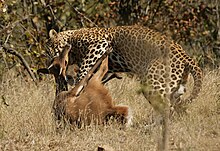
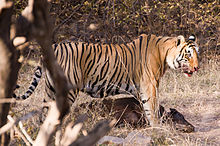
Felidae are highly skilled predators, known for their exceptional hunting abilities. They use stealth and patience to stalk and capture their prey.[40][34] They also have retractable claws that they use to grip and kill their prey quickly and efficiently.[32] Many species of Felidae are highly territorial and establish and defend their home ranges.[51][52] These territories can be quite expansive and are often marked with various scent markings, such as urine or scratch marks on trees.[51][53] These territorial borders help prevent conflicts between individuals and maintain a stable social structure. Most Felidae species are solitary animals, preferring to live and hunt alone. While some species, such as lions, exhibit social behaviors and live in prides, the majority of Felidae are solitary hunters.[34][54][55] This behavior allows them to have access to a larger prey base and reduces competition for food resources. Despite their solitary nature, Felidae still communicate with other individuals.[56] They use various vocalizations, such as roars, growls, purrs, and hisses, to communicate their presence or express emotions.[57] Additionally, body postures and facial expressions are also used for communication, particularly during interactions with potential rivals or mates.[58]

Felidae have diverse reproductive strategies.[59] Some species, like lions, live in social groups where one or a few males will mate with multiple females. Female Felidae typically have a gestation period of about two to three months, and the young are born in litters, except for the cheetah, which usually has a singleton litter. Female Felidae provide maternal care to their offspring after birth. They nurse their young and teach them essential hunting and survival skills. The duration of parental care varies across species, with some providing care for only a few months and others for over a year. Eventually, the young are weaned and become independent.[60][61] Many Felidae species exhibit crepuscular behavior, which means they are most active during dawn and dusk.[51]
Scent marking is an important behavior for Felidae to establish and maintain territories.[62] They use scent glands located in various parts of their bodies to leave scent marks on trees, rocks, or the ground.[58] By doing so, they communicate information about their presence, reproductive status, and territory boundaries to other individuals.[63][60] Felidae are known for their meticulous grooming behavior. They use their rough tongues to clean their fur, removing dirt, parasites, and loose hair. Not only does grooming help keep their coats in optimal condition, but it also serves as a form of self-care and relaxation. Felidae, especially juveniles, engage in play behavior, which serves several purposes. Play helps them develop their hunting skills and coordination.[60] It also facilitates social bonding with littermates and provides mental stimulation. Play behavior can include stalking, pouncing, or wrestling, mimicking the actions they will later use during hunting.
Threats[change | change source]
The primary threats to Felidae species include habitat loss due to deforestation, fragmentation, and human encroachment, leading to the degradation of their natural habitats and reduced prey availability.[49][64] Additionally, illegal poaching, hunting, and retaliatory killings by humans pose a grave threat, often driven by the demand for pelts, claws, bones, and organs.[65][49] Protected area networks have been established globally to safeguard Felidae habitats, ensuring uninterrupted breeding, feeding, and migration opportunities.[66] Initiatives such as reintroduction programs, captive breeding, and predator-prey management aim to stabilize dwindling populations.[60] Efforts are underway to restore degraded Felidae habitats by reforestation initiatives, reducing habitat fragmentation. Promoting corridors and connectivity between protected areas is crucial for felidae to access adequate food sources, mating partners, and escape catastrophic events.[67] Addressing human-wildlife conflict is vital for the survival of felidae. Educating communities about tolerance, implementing livestock protection measures, and promoting non-lethal deterrents help minimize conflict, protecting both human lives and felidae from retaliatory killings.[68] Captive breeding programs ensure genetic diversity and act as insurance populations. Implementing effective breeding strategies, such as the Species Survival Plan, ensures maximum gene diversity, reduces inbreeding, and enhances the overall health and fitness of felidae populations.[69][70][71]
Human interaction[change | change source]
Cultural significance[change | change source]
Captivity[change | change source]
Hunting[change | change source]
See also[change | change source]
References[change | change source]
- ↑ "Felidae". paleobiodb.org. Archived from the original on 2021-07-11. Retrieved 2021-07-04.
- ↑ Wozencraft, W. C. (2005). "Felidae". In Wilson, D. E.; Reeder, D. M (eds.). Mammal Species of the World (3rd ed.). Johns Hopkins University Press. pp. 532–548. ISBN 978-0-8018-8221-0. OCLC 62265494.
- ↑ Valpy, F. E. J. (Francis Edward Jackson) (1828). An etymological dictionary of the Latin language. New York Public Library. London : Printed by A.J. Valpy, sold by Baldwin and Co. p. 150.
- ↑ "History and Origins". egyptianmausociety4. Retrieved 2023-10-05.
- ↑ McKnight, George Harley (1923). English words and their background. David O. McKay Library Brigham Young University-Idaho. New York ; London : D. Appleton and company. pp. 293–311.
- ↑ Pictet, A. (1859). Les origines indo-européennes ou les Aryas primitifs : essai de paléontologie linguistique (in French). Vol. 1. Paris: Joël Cherbuliez. p. 381.
- ↑ Eizirik, E.; Murphy, W. J.; Köpfli, K. P.; Johnson, W. E.; Dragoo, J. W. & O'Brien, S. J. (2010). "Pattern and timing of the diversification of the mammalian order Carnivora inferred from multiple nuclear gene sequences". Molecular Phylogenetics and Evolution. 56 (1): 49–63. doi:10.1016/j.ympev.2010.01.033. PMC 7034395. PMID 20138220.
- ↑ Gaubert, P. & Veron, G. (2003). "Exhaustive sample set among Viverridae reveals the sister-group of felids: the linsangs as a case of extreme morphological convergence within Feliformia". Proceedings of the Royal Society B. 270 (1532): 2523–2530. doi:10.1098/rspb.2003.2521. PMC 1691530. PMID 14667345.
- ↑ Cite error: The named reference
Werdelin_al2010was used but no text was provided for refs named (see the help page). - ↑ Silvestro, D.; Antonelli, A.; Salamin, N. & Quental, T. B. (2015). "The role of clade competition in the diversification of North American canids". Proceedings of the National Academy of Sciences. 112 (28): 8684−8689. Bibcode:2015PNAS..112.8684S. doi:10.1073/pnas.1502803112. PMC 4507235. PMID 26124128.
- ↑ Rothwell, T. (2003). "Phylogenetic systematics of North American Pseudaelurus (Carnivora: Felidae)" (PDF). American Museum Novitates (3403): 1−64. doi:10.1206/0003-0082(2003)403<0001:PSONAP>2.0.CO;2. hdl:2246/2829. S2CID 67753626.[permanent dead link]
- ↑ 12.0 12.1 van den Hoek Ostende, L. W.; Morlo, M. & Nagel, D. (2006). "Majestic killers: the sabre-toothed cats" (PDF). Geology Today. Fossils explained 52. 22 (4): 150–157. doi:10.1111/j.1365-2451.2006.00572.x. S2CID 128960196. Retrieved 2008-06-30.[dead link]
- ↑ Randau, M.; Carbone, C. & Turvey, S. T. (2013). "Canine evolution in sabretoothed carnivores: natural selection or sexual selection?". PLOS ONE. 8 (8): e72868. Bibcode:2013PLoSO...872868R. doi:10.1371/journal.pone.0072868. PMC 3738559. PMID 23951334.
- ↑ Piras, P.; Silvestro, D.; Carotenuto, F.; Castiglione, S.; Kotsakis, A.; Maiorino, L.; Melchionna, M.; Mondanaro, A.; Sansalone, G.; Serio, C. & Vero, V. A. (2018). "Evolution of the sabertooth mandible: A deadly ecomorphological specialization". Palaeogeography, Palaeoclimatology, Palaeoecology. 496: 166−174. Bibcode:2018PPP...496..166P. doi:10.1016/j.palaeo.2018.01.034. hdl:2158/1268434.
- ↑ Johnson, W. E.; Eizirik, E.; Pecon-Slattery, J.; Murphy, W. J.; Antunes, A.; Teeling, E. & O'Brien, S. J. (2006). "The Late Miocene radiation of modern Felidae: a genetic assessment". Science. 311 (5757): 73–77. Bibcode:2006Sci...311...73J. doi:10.1126/science.1122277. PMID 16400146. S2CID 41672825. Archived from the original on 2020-10-04. Retrieved 2019-08-12.
- ↑ Tseng, Z. J.; Wang, X.; Slater, G. J.; Takeuchi, G. T.; Li, Q.; Liu, J. & Xie, G. (2014). "Himalayan fossils of the oldest known pantherine establish ancient origin of big cats". Proceedings of the Royal Society B. 281 (1774): 20132686. doi:10.1098/rspb.2013.2686. PMC 3843846. PMID 24225466.
- ↑ Mazak, J. H. (2010). "What is Panthera palaeosinensis?". Mammal Review. 40 (1): 90−102. doi:10.1111/j.1365-2907.2009.00151.x.
- ↑ Mazák, J. H.; Christiansen, P. & Kitchener, A. C. (2011). "Oldest Known Pantherine Skull and Evolution of the Tiger". PLOS ONE. 6 (10): e25483. Bibcode:2011PLoSO...625483M. doi:10.1371/journal.pone.0025483. PMC 3189913. PMID 22016768.
- ↑ Argant, A. & Argant, J. (2011). "The Panthera gombaszogensis story: The contribution of the Château Breccia (Saône-Et-Loire, Burgundy, France)". Quaternaire. Hors-série (4): 247–269.
- ↑ Johnson, W. E.; O'Brien, S. J. (1997). "Phylogenetic reconstruction of the Felidae using 16S rRNA and NADH-5 mitochondrial genes". Journal of Molecular Evolution. 44 (Supplement 1): S98–S116. Bibcode:1997JMolE..44S..98J. doi:10.1007/PL00000060. PMID 9071018. S2CID 40185850. Archived from the original on 2020-10-04. Retrieved 2019-08-12.
- ↑ O'Brien, S. J. & Johnson, W. E. (2005). "Big cat genomics". Annual Review of Genomics and Human Genetics. 6: 407–429. doi:10.1146/annurev.genom.6.080604.162151. PMID 16124868. Archived from the original on 2020-11-28. Retrieved 2019-08-12.
- ↑ 22.0 22.1 Li, G.; Davis, B. W.; Eizirik, E. & Murphy, W. J. (2016). "Phylogenomic evidence for ancient hybridization in the genomes of living cats (Felidae)". Genome Research. 26 (1): 1–11. doi:10.1101/gr.186668.114. PMC 4691742. PMID 26518481.
- ↑ Werdelin, L. & Olsson, L. (2008). "How the leopard got its spots: a phylogenetic view of the evolution of felid coat patterns". Biological Journal of the Linnean Society. 62 (3): 383–400. doi:10.1111/j.1095-8312.1997.tb01632.x.
- ↑ Cite error: The named reference
Pocock_1917was used but no text was provided for refs named (see the help page). - ↑ McKenna, M. C.; Bell, S. K. (2000). "Family Felidae Fischer de Waldheim, 1817:372. Cats". Classification of Mammals. Columbia University Press. p. 230. ISBN 978-0-231-11013-6. Archived from the original on 2021-04-19. Retrieved 2020-12-31.
- ↑ Cite error: The named reference
CatSG2017was used but no text was provided for refs named (see the help page). - ↑ Piras, P.; Maiorino, L.; Teresi, L.; Meloro, C.; Lucci, F.; Kotsakis, T.; Raia, P. (2013). "Bite of the Cats: Relationships between Functional Integration and Mechanical Performance as Revealed by Mandible Geometry". Systematic Biology. 62 (6): 878–900. doi:10.1093/sysbio/syt053. ISSN 1063-5157. PMID 23925509.
- ↑ Bellani 2019, p. 1.
- ↑ 29.0 29.1 Sunquist 2002, p. 5.
- ↑ 30.0 30.1 30.2 Lamberski, Nadine (2015), "Felidae", Fowler's Zoo and Wild Animal Medicine, Volume 8, Elsevier, pp. 467–476, doi:10.1016/b978-1-4557-7397-8.00047-5, ISBN 978-1-4557-7397-8, PMC 7152389, retrieved 2023-08-16
{{citation}}: CS1 maint: PMC format (link) - ↑ 31.0 31.1 31.2 Macdonald 2010, p. 4.
- ↑ 32.0 32.1 32.2 Sunquist 2002, p. 6.
- ↑ Gonyea, W.; Ashworth, R. (February 1975). "The form and function of retractile claws in the Felidae and other representative carnivorans". Journal of Morphology. 145 (2): 229–238. doi:10.1002/jmor.1051450208. ISSN 0362-2525. PMID 1127699.
- ↑ 34.0 34.1 34.2 SICURO, FERNANDO LENCASTRE; OLIVEIRA, LUIZ FLAMARION B. (2010-10-04). "Skull morphology and functionality of extant Felidae (Mammalia: Carnivora): a phylogenetic and evolutionary perspective". Zoological Journal of the Linnean Society. 161 (2): 414–462. doi:10.1111/j.1096-3642.2010.00636.x. ISSN 0024-4082.
- ↑ Bellani 2019, p. 49.
- ↑ Macdonald 2010, p. 87.
- ↑ Macdonald 2010, p. 88.
- ↑ Bellani 2019, p. 65.
- ↑ Macdonald 2010, p. 84-85.
- ↑ 40.0 40.1 Fraser 2012, p. 4.
- ↑ Publishing, Britannica Educational (2010-10-01). Carnivores. Britannica Educational Publishing. p. 78. ISBN 978-1-61530-385-4.
- ↑ Sunquist, Mel; Sunquist, Fiona (2017-05-15). Wild Cats of the World. University of Chicago Press. p. 6. ISBN 978-0-226-51823-7.
- ↑ Meachen-Samuels, Julie; Van Valkenburgh, Blaire (June 2009). "Forelimb indicators of prey-size preference in the Felidae". Journal of Morphology. 270 (6): 729–744. doi:10.1002/jmor.10712. ISSN 0362-2525.
- ↑ Cuff, Andrew R.; Sparkes, Emily L.; Randau, Marcela; Pierce, Stephanie E.; Kitchener, Andrew C.; Goswami, Anjali; Hutchinson, John R. (July 2016). "The scaling of postcranial muscles in cats (Felidae) I: forelimb, cervical, and thoracic muscles". Journal of Anatomy. 229 (1): 128–141. doi:10.1111/joa.12477. PMC 5341599. PMID 27074986.
{{cite journal}}: CS1 maint: PMC format (link) - ↑ MEACHEN-SAMUELS, JULIE; VAN VALKENBURGH, BLAIRE (2009-03-30). "Craniodental indicators of prey size preference in the Felidae". Biological Journal of the Linnean Society. 96 (4): 784–799. doi:10.1111/j.1095-8312.2008.01169.x. ISSN 0024-4066.
- ↑ Hunter, Luke (2013-06-25). Cats of Africa. Penguin Random House South Africa. pp. Introduction. ISBN 978-1-77584-055-8.
- ↑ Brakefield, Tom (1993). Big Cats. Voyageur Press. p. 16. ISBN 978-1-61060-354-6.
- ↑ Macdonald 2010, p. 6.
- ↑ 49.0 49.1 49.2 Macdonald 2010, p. 14.
- ↑ Castelló 2020, p. 25.
- ↑ 51.0 51.1 51.2 Commission, International Union for Conservation of Nature and Natural Resources Species Survival (1995). Wild Cats. IUCN. pp. 4–6. ISBN 978-2-8317-0050-2.
- ↑ Hunter, Luke (2018-11-15). Field Guide to Carnivores of the World, 2nd edition. Bloomsbury Publishing. p. 7. ISBN 978-1-4729-5080-2.
- ↑ Castelló 2020, p. 18.
- ↑ PETERS, GUSTAV; PETERS, MARCELL K. (2010-09-20). "Long-distance call evolution in the Felidae: effects of body weight, habitat, and phylogeny". Biological Journal of the Linnean Society. 101 (2): 487–500. doi:10.1111/j.1095-8312.2010.01520.x. ISSN 0024-4066.
- ↑ Macdonald 2010, p. 7.
- ↑ Hunter, Luke (2015-10-22). Wild Cats of the World. Bloomsbury Publishing. p. 10. ISBN 978-1-4729-2285-4.
- ↑ Castelló 2020, p. 22.
- ↑ 58.0 58.1 Castelló 2020, p. 21.
- ↑ Brown, Janine L.; Comizzoli, Pierre (2018-01-01), Skinner, Michael K. (ed.), "Female Cat Reproduction", Encyclopedia of Reproduction (Second Edition), Oxford: Academic Press, pp. 692–701, ISBN 978-0-12-815145-7, retrieved 2023-09-19
- ↑ 60.0 60.1 60.2 60.3 Mckenna, Erika Etnyre; Jenna Lande; Alison. "Felidae (cats)". Animal Diversity Web. Retrieved 2023-10-01.
{{cite web}}: CS1 maint: multiple names: authors list (link) - ↑ Castelló 2020, p. 20.
- ↑ Fraser 2012, p. 5.
- ↑ Macdonald 2010, p. 8.
- ↑ Macdonald 2010, p. 16.
- ↑ Thomas, Peggy (2000-01-01). Big Cat Conservation. Lerner Publications. p. 8. ISBN 978-0-7613-3231-2.
- ↑ Nowell 1996, p. 179.
- ↑ Nowell 1996, p. 177.
- ↑ Nowell 1996, p. 180.
- ↑ Nowell 1996, p. 254.
- ↑ Nowell 1996, p. 260.
- ↑ Aquariums, American Association of Zoological Parks and (1981). Species Survival Plan of the American Association of Zoological Parks and Aquariums. American Association of Zoological Parks and Aquariums.
Bibliography[change | change source]
- Bellani, Giovanni G. (2019-09-19). Felines of the World: Discoveries in Taxonomic Classification and History. Academic Press. ISBN 978-0-12-817277-3.
- Fraser, Andrew F. (2012). Feline Behaviour and Welfare. CABI. ISBN 978-1-78064-121-8.
- Sunquist, Mel (2002-08-15). Wild Cats of the World. University of Chicago Press. ISBN 978-0-226-77999-7.
- Macdonald, David Whyte (2010-06-03). The Biology and Conservation of Wild Felids. Oxford University Press. ISBN 978-0-19-923444-8.
- Castelló, José R. (2020-10-20). Felids and Hyenas of the World: Wildcats, Panthers, Lynx, Pumas, Ocelots, Caracals, and Relatives. Princeton University Press. ISBN 978-0-691-20597-7.
- Nowell, Kristin (1996). Wild Cats: Status Survey and Conservation Action Plan. IUCN/SSC Cat Specialist Group. IUCN. ISBN 978-2-8317-0045-8.
